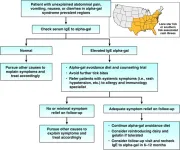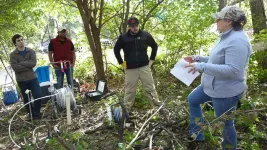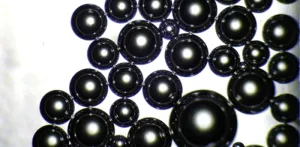(Press-News.org) Utrecht, March 21, 2023 - Recent research from University Medical Center Utrecht (UMC Utrecht) shows that our brain declines later than previously thought. Instead of after our 25th year of life, it happens when we are between the ages of 30 and 40. The researchers published their results in Nature Neuroscience.
Clinical technologist Dorien van Blooijs and neurologist Frans Leijten, together with colleagues from UMC Utrecht and the Mayo Clinic, conducted research into the processing speed of our brain and how it changes as we age.
Faster connections
The researchers discovered, among other things, that the connections in our brain become increasingly faster: from two meters per second in children aged four to four meters per second in people aged between thirty and forty. A doubling, in other words. Only after that age does it slow down. "Our brain continues to develop a lot longer than we thought," Van Blooijs said.
The researchers also see differences between brain regions. The frontal lobe, the front part of our brain responsible for thinking and performing tasks, develops longer than an area responsible for movement. Van Blooijs explains, "We already knew this thanks to previous research, but now we have concrete data." The development of speed is not a straight line, but rather a curve.
Brain map
The researchers obtained the data by making precise measurements using an electrode grid that some epilepsy patients get placed on their brain (under the skull) in preparation for epilepsy surgery. The grid consists of 60-100 electrodes that can measure brain activity. "By stimulating the electrodes using short currents, we can see which brain areas respond abnormally. Thus, we can create a map of which areas should and should not be removed during epilepsy surgery," Leijten said.
The fact that the data could also teach the researchers something about how our brain works was a new insight. "We have been collecting this data for about 20 years," Leijten said. "It wasn't until a few years ago that we realized we could use the unaffected areas as a model for the healthy human brain."
Van Blooijs adds: "If you stimulate an electrode in one area, a reaction occurs in another. That lets you know the two areas are connected. You can then measure how long it takes for the reaction to occur. If you know the distance between the two different brain regions, you can calculate how fast the signal is transmitted."
Better computer models
The results of this study provide important information about our central nervous system. Scientists have long been trying to map the connections in our brain. With this information, experts can make more realistic computer models of our brain.
For these models to work, in addition to information about the connections, precise values concerning the speed of those connections are needed. "We now have these numbers for the very first time," Leijten explains, "With our data, researchers can make new and better computer models that increase our understanding of the brain. We expect our work to not only advances epilepsy research, but also research into other brain disorders."
***
Open to progress
With this publication in Nature Neuroscience, all data has become publicly accessible. This is called Open Science and it means that researchers from all over the world can use the data. Leijten: "By participating in research, patients contribute to progress. The knowledge we gain can be used to better treat future patients." Van Blooijs will receive her doctorate at the end of this year. She says, "A lot is possible with this data, more than we can do. I'm curious to see what kind of research all the creative people around the world will come up with."
END
Decline comes later than previously thought
"Our brain continues to develop longer than we thought", says PhD student Dorien van Blooijs
2023-03-21
ELSE PRESS RELEASES FROM THIS DATE:
LSU Health New Orleans study suggests interprofessional team training could prove effective in AUD prevention & treatment
2023-03-21
New Orleans, LA – An LSU Health New Orleans study demonstrated the effectiveness of single, focused Interprofessional Education (IPE)-based exercises in preparing young health professions learners to limit or prevent alcohol use disorder (AUD). Students learned together as a foreshadowing of future interprofessional practice. This intervention produced significant decreases in the stigma associated with alcohol use, which is highly relevant for potential AUD patients. Results are published in BMC Medical Education, available here.
“These results may translate into more effective and collaborative ...
HonorHealth Research Institute is Arizona’s first to adopt new radiation protection technology in treatment of heart disease
2023-03-21
SCOTTSDALE, Ariz. — March 21, 2023 — HonorHealth Research Institute announced today that it is among the first healthcare providers in the U.S., and the first in Arizona, to use an advanced radiation protection system as part of the diagnosis and treatment of heart disease.
Modern cardiac catheterization laboratories use multiple X-ray beams from different angles to produce high-quality images of the heart, major arteries and other tissues. These low-level radiation beams enable physicians to guide catheters and other devices during interventional cardiology procedures, which are non-surgical, catheter-based therapies for ...
Insights into causes of rare genetic immune disorders
2023-03-21
The cellular glitches underlying a rare genetic disorder called activated PI3K Delta syndrome 2 (APDS2) have been identified by researchers at the Garvan Institute of Medical Research. The disorder is caused by genetic variations that disrupt immune cell signalling through a protein called PI3K.
“This study tells us how signalling in the immune system needs to be tightly balanced to make an effective response to infection. Sometimes it’s turned down and you have a problem, and sometimes signalling being turned up can interfere with an immune ...
Lone star tick bites may be to blame for unexplained digestive problems
2023-03-21
Bethesda, MD (March 21, 2023) — The American Gastroenterological Association (AGA) has released new clinical guidance to help physicians and patients identify if unexplained digestive symptoms are due to alpha-gal syndrome, a food allergy that is caused by lone star tick bites. The AGA Clinical Practice Update was published today in Gastroenterology.
Alpha-gal syndrome is an allergy that causes your body to react to eating meat from mammals and products made from mammals. Symptoms usually start 2-6 hours after eating the mammalian meat or food.
Clinicians should consider alpha-gal syndrome in patients ...
Forests reduce health risks, new global report confirms
2023-03-21
Forests, trees and green spaces play a vital role in ensuring a healthy life for all on a global scale.
The health benefits of forests and trees, ranging from physical and mental well-being to overall mortality reduction, far outweigh the adverse effects on health. As health threats, such as forest fires, are mainly caused by human activities, urgent action is needed.
In order to address health challenges, it is important to recognize the close links between human health and the health of other species, of ecosystems, and of the planet as a whole.
Vienna, March, 21, 2023 - The global scientific evidence of the multiple types of benefits ...
ASBMB cautions against drastic immigration fee increases
2023-03-21
The American Society for Biochemistry and Molecular Biology sent recommendations to the U.S. Citizenship and Immigration Services related to the agency’s proposed changes to petition processing fees. The USCIS proposed increasing its filing fees for employment-based visas by up to 2,050%, a measure intended to remedy financial deficits at USCIS and ramp up hiring to improve services. The ASBMB expressed concern about how “the proposed rule is likely to harm the retention of highly skilled foreign-born scientific researchers.”
The ...
A new sight for the electrochemical stability in halide electrolytes
2023-03-21
They published their work on February in Energy Material Advances.
"Constructing an efficient ionic/electronic framework is crucial for the development of high-performance solid-state batteries," said Dr. Chuang Yu, a professor at the State Key Laboratory of Advanced Electromagnetic Engineering and Technology at Huazhong University of Science and Technology. "Currently, the application of solid-state batteries with inorganic electrolytes is challenging because most solid electrolytes have an unsatisfactory low oxidation potential."
According to Dr. Yu, halide electrolytes have been found to be cathode-stable materials with relatively wide electrochemical ...
Study confirms nitrate can release uranium into groundwater
2023-03-21
Eight years ago, the data was sound but only suggestive, the evidence strong but circumstantial.
Now, the University of Nebraska–Lincoln’s Karrie Weber and colleagues have experimentally confirmed that nitrate, a compound common in fertilizers and animal waste, can help transport naturally occurring uranium from the underground to groundwater.
Their new research backs a 2015 Weber-led study showing that aquifers contaminated with high levels of nitrate — including the High Plains Aquifer residing beneath Nebraska — also contain uranium concentrations far exceeding a threshold set by the Environmental Protection Agency. Uranium concentrations above that EPA threshold ...
PNAS announces six 2022 Cozzarelli Prize recipients
2023-03-21
WASHINGTON, DC – The Editorial Board of the Proceedings of the National Academy of Sciences (PNAS) has selected six papers published by PNAS in 2022 to receive the Cozzarelli Prize, an award that recognizes outstanding contributions to the scientific disciplines represented by the National Academy of Sciences (NAS). Papers were chosen from more than 3,200 research articles that appeared in the journal last year and represent the six broadly defined classes under which the NAS is organized. Additionally, the Editorial ...
Using optics to trace the flow of microplastics in oceans
2023-03-21
Microplastics are tiny plastic particles less than 5 mm in diameter that have emerged as a novel marine environment pollutant. Microplastics usually result from a breakdown of larger plastic debris but can also be generated from plastic microbeads used in personal care products. Over the years, there has been a significant buildup of microplastic pollutants in our oceans, with a recent estimate that the world’s oceans contain over 24.4 trillion pieces of microplastics weighing between 82,000 and 578,000 tons. It is highly likely that ...
LAST 30 PRESS RELEASES:
Injectable breast ‘implant’ offers alternative to traditional surgeries
Neuroscientists devise formulas to measure multilingualism
New prostate cancer trial seeks to reduce toxicity without sacrificing efficacy
Geometry shapes life
A CRISPR screen reveals many previously unrecognized genes required for brain development and a new neurodevelopmental disorder
Hot flush treatment has anti-breast cancer activity, study finds
Securing AI systems against growing cybersecurity threats
Longest observation of an active solar region
Why nail-biting, procrastination and other self-sabotaging behaviors are rooted in survival instincts
Regional variations in mechanical properties of porcine leptomeninges
Artificial empathy in therapy and healthcare: advancements in interpersonal interaction technologies
Why some brains switch gears more efficiently than others
UVA’s Jundong Li wins ICDM’S 2025 Tao Li Award for data mining, machine learning
UVA’s low-power, high-performance computer power player Mircea Stan earns National Academy of Inventors fellowship
Not playing by the rules: USU researcher explores filamentous algae dynamics in rivers
Do our body clocks influence our risk of dementia?
Anthropologists offer new evidence of bipedalism in long-debated fossil discovery
Safer receipt paper from wood
Dosage-sensitive genes suggest no whole-genome duplications in ancestral angiosperm
First ancient human herpesvirus genomes document their deep history with humans
Why Some Bacteria Survive Antibiotics and How to Stop Them - New study reveals that bacteria can survive antibiotic treatment through two fundamentally different “shutdown modes”
UCLA study links scar healing to dangerous placenta condition
CHANGE-seq-BE finds off-target changes in the genome from base editors
The Journal of Nuclear Medicine Ahead-of-Print Tip Sheet: January 2, 2026
Delayed or absent first dose of measles, mumps, and rubella vaccination
Trends in US preterm birth rates by household income and race and ethnicity
Study identifies potential biomarker linked to progression and brain inflammation in multiple sclerosis
Many mothers in Norway do not show up for postnatal check-ups
Researchers want to find out why quick clay is so unstable
Superradiant spins show teamwork at the quantum scale
[Press-News.org] Decline comes later than previously thought"Our brain continues to develop longer than we thought", says PhD student Dorien van Blooijs





